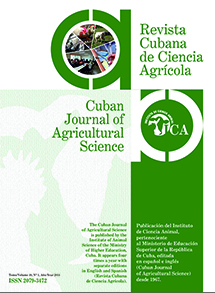Bromatological characterization of coffee (Coffea arabica L.) pulp for animal feeding purposes
Main Article Content
Abstract
sampling, a brief characterization of production systems was carried out, through a survey to producers from the selected cantons. In the laboratory, dry matter content, organic matter, ashes, ether extract, crude protein, crude fiber and nitrogen-free extract, neutral detergent fiber and cellular content were determined. The results of the surveys showed that in 100 % of the farms, Arabian coffee of the typical variety is cultivated. There is also similarity in crop management and processing method. Regarding the bromatological analysis, no difference
was observed in the nutrient content of coffee pulp among cantons, with mean values of 19.46 % for dry matter, 89.55 % for organic matter, 10.45 % for ashes, 2.23 % for ether extract, 10.02 % of crude protein, 19.24 % of crude fiber, 58.06 of nitrogen-free extract, 44.24 of neutral detergent fiber and 55.76 of cellular content. It is concluded that the bromatological
composition of coffee pulp is in the ranges reported by the literature, without showing variations among the studied cantons. Therefore, this could be an interesting residue for its used as raw material for animal feeding.
Keywords: agricultural residues, bromatological composition, animal feeding
Article Details
Those authors that have publications with this journal accept the following terms:
1. They will retain their copyright and guarantee the journal the right of first publication of their work, which will be simultaneously subject to the License Creative Commons Attribution-NonCommercial 4.0 International (CC BY-NC 4.0) that allows third parties to share the work whenever its author is indicated and its first publication this journal. Under this license the author will be free of:
- Share — copy and redistribute the material in any medium or format
- Adapt — remix, transform, and build upon the material
- The licensor cannot revoke these freedoms as long as you follow the license terms.
Under the following terms:
- Attribution — You must give appropriate credit, provide a link to the license, and indicate if changes were made. You may do so in any reasonable manner, but not in any way that suggests the licensor endorses you or your use.
- NonCommercial — You may not use the material for commercial purposes.
- No additional restrictions — You may not apply legal terms or technological measures that legally restrict others from doing anything the license permits.
2. The authors may adopt other non-exclusive license agreements to distribute the published version of the work (e.g., deposit it in an institutional telematics file or publish it in a monographic volume) whenever the initial publication is indicated in this journal.
3. The authors are allowed and recommended disseminating their work through the Internet (e.g. in institutional telematics archives or on their website) before and during the submission process, which can produce interesting exchanges and increase the citations of the published work. (See the Effect of open access).
